Caring for cactus plants isn’t as difficult as many people think, and they’re actually quite easy to grow in the right conditions.
Plus they can live for a lifetime once you know how to create their ideal environment and provide the best care.
This complete guide will teach you all of that. You’ll discover how to grow cactus plants indoors or outdoors with tips on where to plant them.
You’ll also learn about how much water, soil, sunlight, and fertilizer they need, as well as propagation, flowering, temperature, and more, so you can keep them thriving for many years to come.
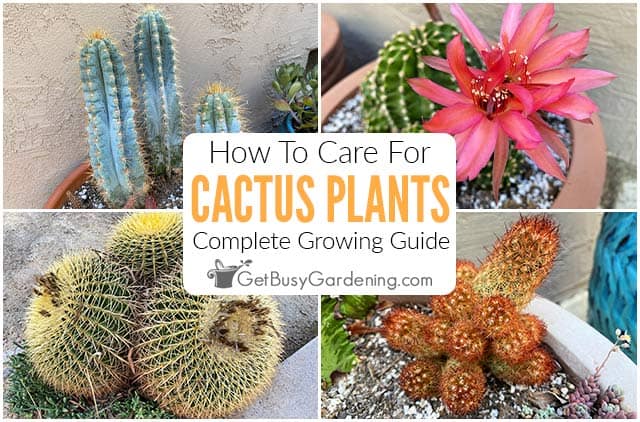
What Is A Cactus
All cacti are members of the Cactaceae family, and are known for their high heat tolerance and drought resistance.
Most originated in the deserts of North and South America, but today they can be found all over the world.
The Cactaceae family is technically a sub-category of succulents, which means they store water in the stems and leaves. They’re also slow-growing perennials that can often live for hundreds of years.
The appearance, size, color, growth habit, and flowers range widely across the different species.
They can grow from a single central stem, or they can be barrel-shaped, tubular, flat, or round. They’re well known for having spiky spines, but they can also be smooth or even fuzzy.
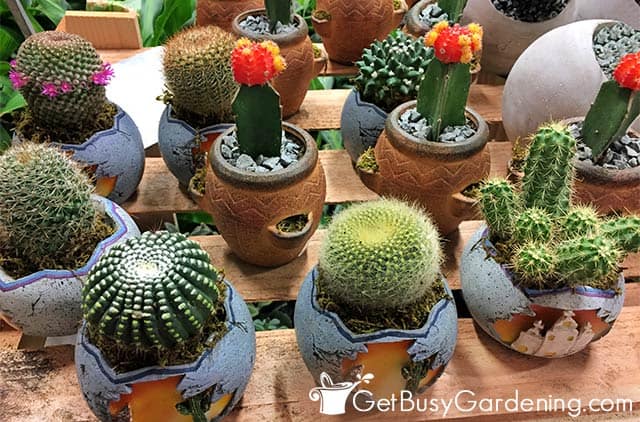
Different Types Of Cactus Plants
With thousands of different types of cacti to choose from, it’s impossible to list them all in one post.
But there are some that are more popular among gardeners. Here are a few of my favorites.
- Barrel cactus
- Saguaro
- Old man cactus
- Prickly pear
- Monkey tail cactus
- Brain cactus
- Rat tail cactus
- Bunny ears
- Moon cactus
- Pincushion cactus
- Star cactus
- Organ Pipe cactus
- Hedgehog cactus
- Peanut cactus
- Fairy Tale cactus
- Parodia magnifica
- Walkingstick cactus
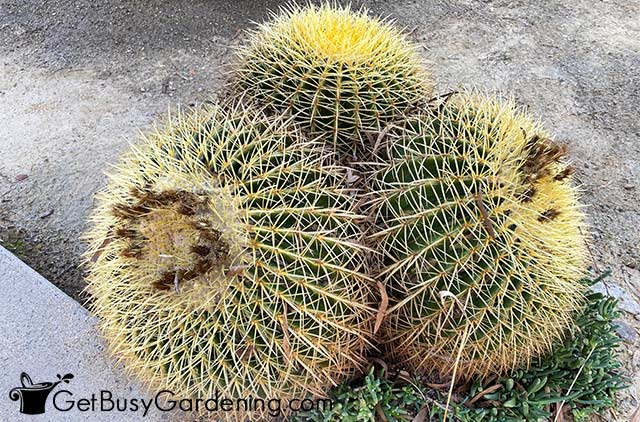
Flowers
With the proper care, most cacti will flower every year. The aroma, size, color, and shape totally depend on the species.
The blossoms commonly appear during the spring or summer, but some will bloom during the cooler months.
Several unique types will bloom for a single day, or even at night, while others will last much longer.
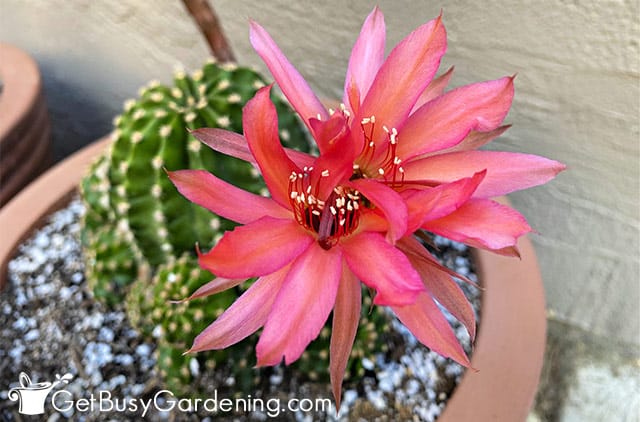
Toxicity
The toxicity of cactus plants will depend on the variety you grow. Many are non-toxic to cats and dogs, but have other dangers like sharp spikes or spines to consider for their safety.
Check the ASPCA website for your specific type to verify that it’s safe to have around pets.
How To Grow Cactus Plants
Before we talk about cactus care specifics, we should chat about where and when to grow them. The right timing and location are key to their longevity.
Hardiness
You’ll probably be surprised to learn that some cacti are remarkably cold hardy. Whether you live in growing zone 1 or 13, there is a cactus that will survive in your area.
It’s important to choose the right one. For example, hardier ones can survive all the way down to -60°F (-51.1°C) outdoors, while others will suffer with a light frost. Always check the label on whichever species you’re considering.
If you fall in love with one that won’t survive outside year round, consider growing it in a container that you can bring inside when it gets too cold or keeping it as a houseplant year-round.
Where To Grow Cacti
Different varieties may have specific requirements about the best location, but a general rule of thumb is that a cactus needs lots of heat and sun.
They also do not like wet feet or humidity, and can easily rot in overly damp conditions.
Choose a location outdoors that receives a minimum of 6 hours of direct sun per day where the ground is rocky or sandy and drains freely.
For indoor cacti, find a spot near a south-facing window or other bright area. Always use a container that has drainage holes and a coarse or gritty fast-draining soil.
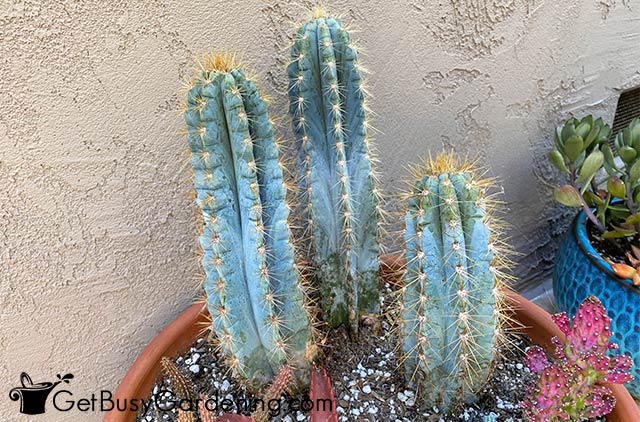
Cactus Care & Growing Instructions
Now that you have the perfect spot in mind, it’s time to learn how to care for a cactus. The best part about them is that they only need a little bit of attention to thrive.
Light
Whether indoors or out, all cacti need 6+ hours of sunlight per day. This can be bright light inside the house, or full sun out in your garden.
Too much shade can cause stunted, slow, or leggy growth, and prevent flowering.
However, some can be sensitive to high heat and direct sun, and may start to burn during heat waves.
If that happens with yours, protect them during the hottest part of the day using a screen cloth, or move them to an area that gets afternoon shade.
If you have trouble finding the right spot indoors, add a grow light to help supplement.
Water
By far the most common issue beginners have with cactus plant care is overwatering. It’s the number one cause of their death.
Cacti store water in their leaves and pads, so they don’t require nearly as much as other plants. You can get tons of specific tips in my cactus watering guide, but here are the basics.
Wait until the soil dries out completely between drinks. Then water deeply, but make sure all of the excess drains completely, and the soil is never soggy, as this can cause rot.
If you struggle to get it right, buy yourself a moisture gauge probe. It will help you understand when the plant is truly dry so never overdo it.
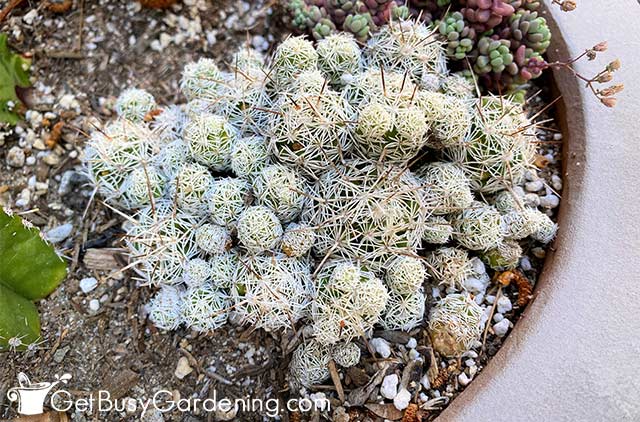
Humidity
Just like overwatering, high humidity can also cause issues of rot, even if the soil stays dry. Some cacti are more tolerant than others, but most prefer an arid to semi-arid environment.
Since indoor air is typically drier, especially during the winter months, it makes an ideal setting for cacti to grow.
Temperature
Many cactus plants are remarkably temperature tolerant. Their native desert climate often features both extremes – from very high heat to below freezing.
Some, however, can be killed by a light frost or get sunburned if it exceeds 100°F (37.7°C).
The exact temperature range depends on the species of cactus you’re growing. Always check the plant tag to make sure you know what’s ideal for yours.
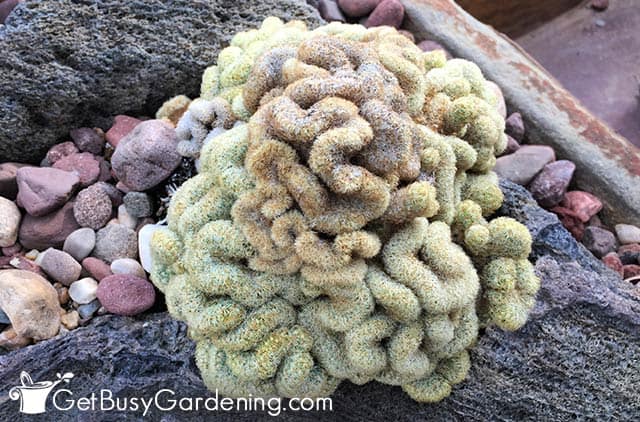
Fertilizer
Regular feedings during the growing season are an important part of cactus care. Not only does it stimulate growth, but it can help encourage blooming.
Use an organic cactus specific formula, a balanced liquid fertilizer, or compost tea a few times per year from spring through summer.
Or, apply slow-release granules once anually at the beginning of the most active growth period.
Soil
One very key component of cactus care is choosing the right soil. The best mixes are chunky, dry, aerated, and sandy or rocky.
Those qualities will ensure that water drains off quickly, which is exactly what you want.
You can purchase a good quality commercial mix, or make your own by amending regular potting soil with things like perlite, pumice, and coarse sand.
If you’re not sure how, get the recipe for the ideal mixture in my post about making DIY cactus soil.
Transplanting & Repotting
Another reason that cactus care is so low maintenance is that they grow slowly and don’t need repotting often.
However if yours has roots showing from the bottom or a bulging or cracked pot, it may be time to size up.
Wait until new growth has started in the spring or early summer. This is also the best time for transplanting them to a new location in your garden.
Always use a pot with drainage holes that’s 1-2” larger than the previous container. Use thick gloves to handle it, and bury it at the same depth. Pack in the rest of the pot gently to hold it in place.
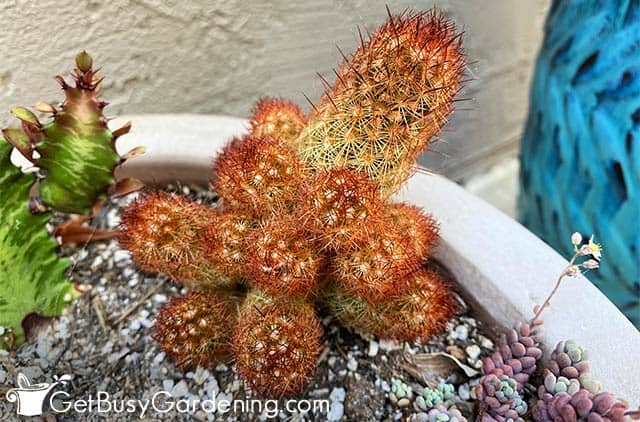
Pruning
While it can vary between different types of cactus, most will very rarely need pruning. However, you can trim it to remove damaged or dead areas, or to encourage branching.
Tackle it in the spring or summer while the plant is doing most of its growing. Use a good quality pair of clean, sterile pruners, loppers, or a pruning saw, and always wear heavy-duty gloves.
Pest Control Tips
Pests can become an issue for cacti both indoors or outside the garden, especially if your plant is not in great health. Scale, mealybugs, and cactus bugs are the most common culprits.
Insecticidal soap is a good method of control. I make my own by combining 1 teaspoon of mild liquid soap with 1 liter of water.
Neem oil can also be effective, but some cacti are sensitive to it, so make sure you test it in a small area before applying it to the entire plant.
Cactus Propagation Tips
The best way to propagate your cactus will depend on the species, but most can be multiplied through stem cuttings or offsets taken from the plant in the spring or summer.
Both offsets and cuttings can often be rooted in the same way. Carefully remove them from the plant with sharp pruners and let them dry for a day or two. The cut end needs to form a callus to prevent rot.
Then, dust the cut end with rooting hormone and plant it in a very coarse, lightly dampened medium. Keep it in a bright location until new growth begins, then pot it up or transplant it.

Troubleshooting Common Problems
Cactus care is usually very easy, but no plant is completely trouble free. If you run into one of these more common issues, my tips can help you get back on track.
Yellowing Cactus
Yellow spots or patches on your cactus are a sign of stress. They can be caused by lack of sunlight, sunburn, improper watering, the wrong soil, or temperature fluctuations.
Make sure yours is getting 6+ hours of light per day in dry, gritty soil. Use a moisture gauge to help monitor how much water it’s getting to prevent overdoing it.
White Spots On Cactus
If you see white spots on your cactus it’s most likely caused by a fungal issue or bugs.
Check for a sticky cottony buildup or hard white patches, which can indicate mealybugs or scale. Treat pests right away with insecticidal soap or neem oil.
If there are no signs of bugs, check for rot. You can also try applying an organic fungicide to stop issues like mildew or mold from spreading, and make sure your cactus is not getting too much humidity.
Soft Brown Spots Or Stem
Soft spots that occur on the stem or other parts of your cactus are likely a sign of rot. This is usually caused by high humidity or overwatering.
There are ways to save your cactus if it hasn’t gotten too bad. Check out my guide on managing cactus rot for detailed info on how to handle it.
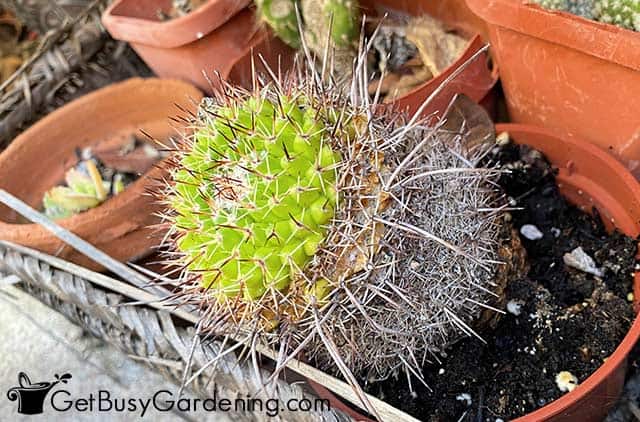
FAQs
Here I’ve answered some of the most commonly asked questions about cactus plant care. If yours isn’t listed, please add it to the comments section below.
Are cacti easy to grow?
Most cacti are easy to grow because they retain water and require very little hands-on care. With enough sun, coarse soil, and the occasional drink, they’re a very low maintenance plant.
Is a cactus an indoor or outdoor plant?
A cactus can often be grown either indoors or outdoors successfully. The location you choose depends on the size and variety you have, as well as where you live. Some do better inside where they’re protected from cold weather, while others are too large or need more direct sun and heat.
How long can a cactus live?
Some cactus plants can live for hundreds of years with the proper care. How long yours will survive depends on the species and its environment. Providing it with right growing conditions will help it live as long as possible.
Are cactus plants succulents?
Yes, cactus plants are succulents, but not all succulents are cacti. The Cactaceae family is a subcategory of succulents because they’re a type of water-storing plant.
How long does it take for a cactus to grow?
How long it takes for a cactus to grow depends on the variety and its care. Lots of sunshine, well-drained soil, and the occasional fertilizer will speed things along, but most are naturally very slow-growing, even under perfect conditions.
How do I keep my cactus healthy?
The best way to keep your cactus healthy is to understand its needs. Provide it with 6 or more hours of bright or direct light a day, water only when it’s dry, feed it with organic fertilizer while it’s actively growing, and understand the temperature range it can tolerate.
Is a cactus a good houseplant?
A cactus makes a great houseplant because they thrive in the dry air and consistent temperatures commonly found indoors, and are happy even when you ignore them for long periods of time.
If you want to learn all there is to know about maintaining healthy indoor plants, then you need my Houseplant Care eBook. It will show you everything you need to know about how to keep every plant in your home thriving. Download your copy now!
More Houseplant Care Guides
- How To Grow & Care For Tropical Houseplants Indoors
- Christmas, Thanksgiving, & Easter Cactus: How To Tell Them Apart
- How To Care For Ric Rac Cactus (Epiphyllum anguliger)
Share your cactus care tips in the comments section below.
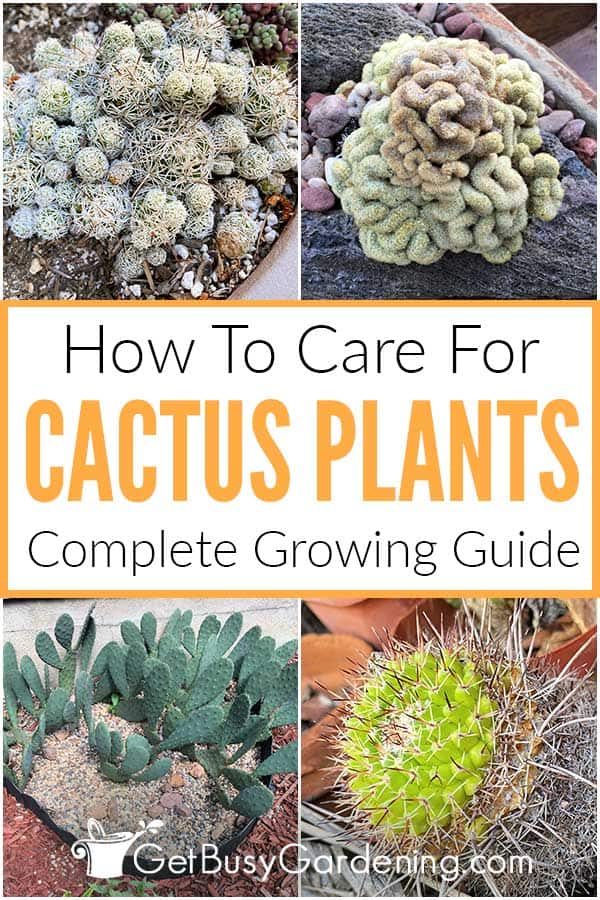
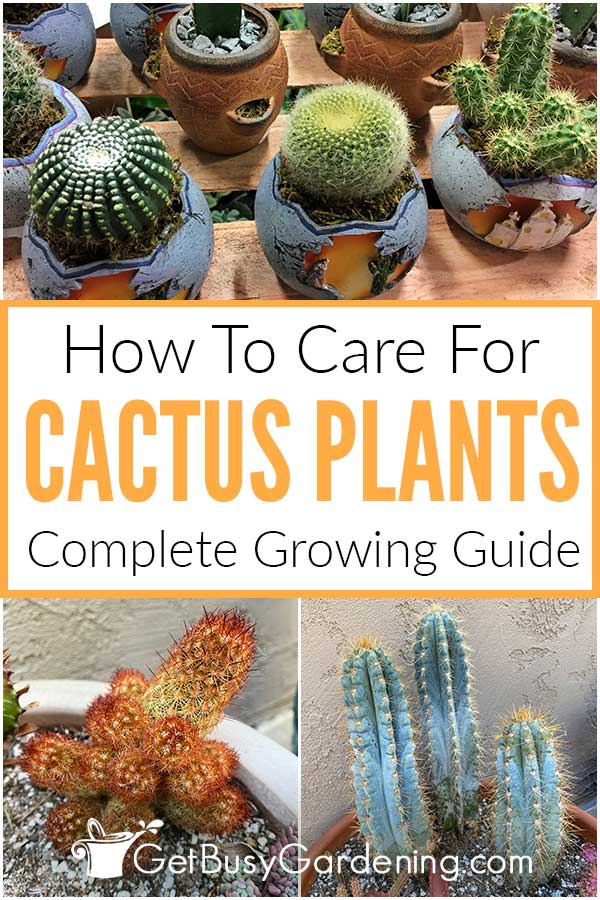
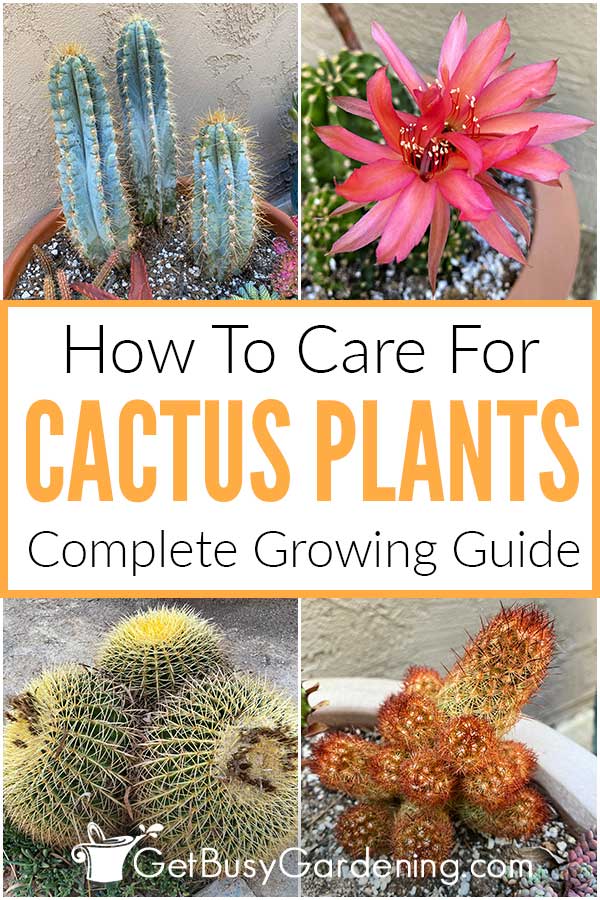




Leave a Reply